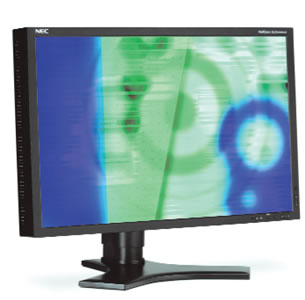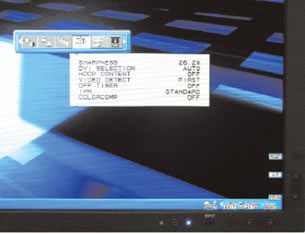Premium Picture at a Premium Price
This new 24-in. LCD monitor from NEC delivers incredible color and rock-solid performance.
Latest News
December 4, 2001
By David Cohn
 The new NEC LCD2490WUXi, a high-end 24-in. LCD wide-screen monitor, is capable of producing some of the most accurate colors of any LCD. |
NEC has been manufacturing monitors for as long as I can remember, but amazingly this is the first time I’ve had the opportunity to review one of NEC’s LCD displays. The company recently sent Desktop Engineering one of its newest monitors, the 24-in. NEC MultiSync LCD2490WUXi wide-screen monitor.
The LCD2490WUXi and its 26-in. sibling, the LCD2690WUXi, are the latest members of the NEC MultiSync 90-series of monitors. The new displays qualify as Windows Vista Premium monitors and are positioned within the company’s high-end professional line. As such, they are compatible with both of NEC’s display calibration software packages (SpectraView II and GammaComp MD, each sold separately) and use in-plane switching, which NEC claims is the highest performing LCD technology available. They both feature HDCP (High Bandwidth Digital Content Production), which is supported through the DVI-D connector and allows for use with HDCP-equipped devices and encrypted content. Both models also mark NEC’s unveiling of a new feature called X-Light Pro, which uses the display’s internal luminance and color sensor to achieve a consistent light output level for the useful life of the display. The two displays also use ColorComp, an NEC technology that compensates for differences in color and luminance at each pixel to maintain image uniformity. And both models feature 1920 X 1200 native resolution, a 16:10 aspect ratio, and display up to 16,777,216 colors.
The new monitors also feature an internal programmable 12-bit lookup table providing for calibration as well as more points of shading between black and white, and overall improved representation of gamma curves. NEC’s AmbiBright technology automatically adjusts the display’s backlight based on ambient lighting while black-level adjustment enables black levels to more closely resemble those on a CRT. Other technologies include Digital CableComp, enabling you to use digital cables up to 30 meters (100 meters for analog) without any image degradation, and GammaComp for selection of preset or customization of gamma curves.
 Eight buttons in the lower-right corner of the bezel control the powerful on-screen menu. Notice the button labels that display adjacent to the buttons when the OSM is active. |
The 2490 arrived mounted on its pedestal base, which enables the monitor be raised and lowered over a 6-in. vertical range. The panel also tilts from -5 to + 30 degrees and rotates to a portrait or landscape orientation, but does not swivel.
The panel itself measures 21.8 in. X 14.2 in., but at 4- in. deep is twice as thick as most of the other LCDs we’ve reviewed. But the thin bezel (16.9mm) makes the monitor ideal for multiple-monitor configurations, and the monitor supports NEC’s Tile Matrix function, which allows an image to be split across up to 25 individual monitors. Mounted on its base, the entire package weighs 26 pounds. The panel can be easily removed from the base and NEC provides four screws for mounting the panel to an optional flexible arm.
The active matrix TFT panel has a contrast ratio of 800:1 and a brightness of 400cd/m2. The 0.27mm dot pitch is pretty standard for a 24-in. LCD. With horizontal and vertical viewing angles of 178 degrees, we were able to view the monitor from virtually anywhere in the room with no discernable reduction in brightness or clarity.
In addition to its native resolution, the LCD2490WUXi supports most common lower resolutions. There are three inputs — DVI-D, DVI-I, and 15-pin D-Sub as well as a DC-out port — but no USB hub. NEC supplies three video cables (DVI-D, 15-pin mini D-sub male to DVI-A, and a mini D-Sub cable) as well as a power cable. Cables can be routed through plastic latches on the rear of the pedestal base and then somewhat concealed behind a plastic cover. It’s a nice idea, but doesn’t function well if you rotate the monitor frequently from landscape to portrait mode.
NEC LCD2490WUXi LCD NEC Display Solutions of America Price: $1,499.99 MSRP Size: 24.1-in. (diagonal) Display type: active matrix TFT (thin film transistor) Max Measurements: 21.8 in. X 22.9 in. X 12.0 in. (W X H X D) assembled on base Weight: 26 pounds Native resolution: 1920 X 1200 pixels at 60 Hz Horizontal frequency range: 31.5-93.8 kHz analog, 119.2 kHz digital Vertical refresh rate: 50-85 Hz Display brightness: 400cd/m2 Contrast ratio: 800:1 Dot pitch: 0.270mm Response time: 16ms (8ms gray to gray) Connections: DVI-D, DVI-I, and VGA (15-pin D-sub) Power range: 100-240 volts, 50/60 Hz Power consumption: 83 watts, 1 watt in savings mode I/O ports: none Other features: tilt/swivel base, portrait/landscape pivot, DVI-D to DVI-D cable, Mini D-Sub cable, 15-pin mini D-Sub male to DVI-A cable, screws for attaching to optional flexible arm, cable cover Warranty: 4 years parts and labor including backlight |
This NEC monitor may have one of the coolest (and most complex) on-screen menus (OSM) that we’ve ever seen, and the printed manual devotes 21-pages to describing its functions. Eight buttons (two sets of which are paired) in the lower-right corner of the bezel provide a wealth of control. From left to right, there’s an ambient light sensor that automatically adjust various settings when the auto-brightness control is enabled. A power button turns the monitor on and off and an adjacent LED glows blue when the monitor is on. An input selector button toggles through the input sources or switches to the OSM controls for selecting input sources if no other input sources are detected. The third button over brings up the main OSM and also displays on-screen key guides adjacent to the other buttons. You can then maneuver your way through the menus to adjust various settings.
But if you turn the monitor off and then turn it back on again while pressing both the power and input buttons, you can display an advanced menu, which has a number of additional controls, including changing the black level, adjusting the vertical and horizontal position and sharpness of individual RGB colors, and even setting an internal clock and programming a weekly schedule for turning the monitor on and off. With all of these controls, managers will appreciate the fact that they can also lock access to the OSM so that users don’t inadvertently make changes that would degrade the image. You can lock out all OSM features or still allow users to adjust brightness and contrast.
While in the advanced OSM, I was able to turn on an auto-detect feature that automatically reorients the display when you rotate the monitor between landscape and portrait mode, but this proved to be less useful than I anticipated. Rather than rotating from 1920 X 1200 to 1200 X 1920 when switching from landscape to portrait mode, the screen maintains the larger horizontal resolution, so that the resulting image is stretched vertically and compressed horizontally. Users will be much better served by manually changing the screen image rotation from within their video drivers or using special software (such as Pivot from Portrait Displays; portrait.com), but it is nice that the OSM can change orientation automatically when you rotate the panel.
We used DisplayMate from DisplayMate Technologies (displaymate.com) to help evaluate the visual quality of the monitor. DisplayMate uses a series of test patterns both to help users fine-tune the image and to uncover any picture quality or video artifacts that might otherwise go unrecognized. The NEC LCD2490WUXi displayed excellent gray scales and showed no pixel defects. We were able to read text down to 6.8 points, even at different intensity levels. The panel’s fast response time resulted in no image smearing when viewing full-motion video, and if you do notice any blurring when playing games or watching DVDs, an Overdrive setting (accessible in the advanced OSM) further improves gray-to-gray response time.
NEC backs the MultiSync LCD2490WUXi with a four-year warranty that covers parts and labor, including the backlight, and 24/7 tech support. Although the monitor doesn’t approach the ultra-high 2560 X 1600 resolution of a 30-in. monitor, its image is crystal clear and rock solid. You will pay a premium for NEC quality, however. The 2490WUXi has a manufacturer’s suggested retail price of $1,500 (and an estimated street price of $1,400), nearly double that of some other 24-in. displays we’ve reviewed and just a few hundred dollars less than most 30-in. panels. But these new NEC monitors are capable of producing some of the most accurate colors of any LCD, more than justifying the premium for those with demanding, color-critical applications.
David Cohn is a computer consultant and technical writer based in Bellingham,WA, and has been benchmarking PCs since 1984. He’s a contributing editor to DE, an applications engineer with The PPI Group, and the author of more than a dozen books. Please send comments about this article to DE-Editorsmailto:[email protected]. You can also contact David at [email protected].
Subscribe to our FREE magazine, FREE email newsletters or both!
Latest News
About the Author
David Cohn is a consultant and technical writer based in Bellingham, WA, and has been benchmarking PCs since 1984. He is a Contributing Editor to Digital Engineering, the former senior content manager at 4D Technologies, and the author of more than a dozen books. Email at [email protected] or visit his website at www.dscohn.com.
Follow DE





